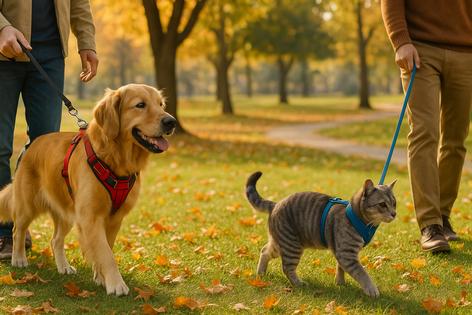Harnesses Gain Ground as Pet Owners Seek Safety and Comfort
Published in Cats & Dogs News
Pet owners across the country are rethinking collars for their cats and dogs. Harnesses, once viewed as a niche product for specialized training, have become mainstream in recent years as more owners focus on animal safety and comfort during walks.
Why harnesses are gaining popularity
For dogs, harnesses provide greater control without putting strain on the neck. Traditional collars, especially on excitable pets that pull, can cause throat injury or aggravate conditions like tracheal collapse. Harnesses distribute pressure across the chest and shoulders, reducing those risks.
Cats, traditionally kept indoors, are also venturing outdoors more often in controlled ways. Harnesses allow cats to explore yards, parks and even hiking trails while preventing escape. With social media filled with videos of “adventure cats,” many owners are trying harnesses as a way to enrich their pets’ lives.
Designs that fit different needs
Harnesses come in multiple styles. Step-in harnesses let pets place their front paws into the openings before being fastened on the back, making them quick to secure. Vest-style harnesses provide wider surface coverage and often have padding, which can be reassuring for both owner and pet.
For cats, lighter designs are essential. Feline anatomy differs from dogs, with more flexible shoulders and narrow torsos. A cat harness must fit snugly to prevent backing out, while remaining breathable and nonrestrictive. Adjustable straps and secure clips are crucial features.
Training tips for success
Introducing a harness should be gradual, veterinarians and trainers say. Pets may resist initially, and forcing the issue can create negative associations.
Experts recommend letting the animal sniff and investigate the harness before placing it on. Short indoor sessions, paired with treats and praise, build tolerance. For cats, sessions may start as brief as a minute or two. Once the pet walks comfortably indoors, owners can progress to leashed walks outdoors.
Consistency and patience are key. “It’s about building trust,” said Dr. Mariah Santos, a small-animal veterinarian in Denver. “Owners who take time to acclimate their pets usually see the best results.”
Safety considerations
Harnesses are not without risks. Poorly fitted harnesses can chafe under the legs or allow escape if too loose. Straps that are too tight can cause discomfort or restrict breathing. Experts advise ensuring you can slide two fingers between the harness and the pet’s body.
Owners should also inspect harnesses regularly for wear and tear. Frayed straps or weakened clips can fail under pressure, especially with strong dogs. For cats, even a small break could mean a sudden dash into traffic or an unfamiliar environment.
Reflective stitching or bright colors add visibility during early-morning or evening walks, an increasingly popular feature among manufacturers.
Benefits beyond the walk
Harnesses may also serve therapeutic purposes. Dogs with orthopedic conditions sometimes walk more comfortably with chest support. Service and therapy animals often use specialized harnesses that allow handlers to guide or lift when necessary.
For cats, harness use can reduce boredom-related behaviors such as scratching furniture or overeating. Outdoor exploration, even in short sessions, can satisfy curiosity and reduce stress.
The bottom line
Harnesses are not a one-size-fits-all solution. They require investment in the right fit, training and consistent use. But for many pet owners, the benefits outweigh the challenges.
“Walking with my cat on a harness changed both of our lives,” said Olivia Reed of Portland, Oregon. “He gets to smell the flowers, watch the birds and burn energy safely. It makes our bond stronger.”
As more owners look for ways to blend safety with enrichment, harnesses are likely to remain a fixture in the pet aisle—and on trails and sidewalks around the country.
========
This article was written, in part, utilizing AI tools.









Comments